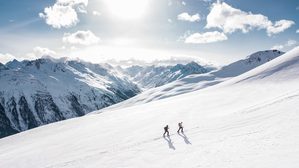How Much Snow To Ski
by Frank V. Persall
The cold winter days are starting to close in. It's around this time of year that holiday goers will start thinking about organizing their yearly skiing trips. The big question is how much snow do you need to ski? Or when is the best time of year to go skiing?
Contents
How Much Snow Is Enough To Ski?

It's the age-old question, and unfortunately, it can vary from place to place due to many different factors. Many skiers will tell you it's not really about how much snow is enough but more what's underneath the snow that counts. So what should skiers really be looking for?
Before a skier starts getting out on the slopes, they should learn and understand what terrain lays beneath the snow to really understand how much snowfall they need to ski the mountain suitably. Not only will this help avoid injury, but it will give the skier better knowledge of what lies underneath.
So, let's put it into perspective like mentioned before some pistes (a trail that skiers follow) are extremely rocky underneath the snow. If a skier is running that piste, they may need at least seven feet of snow to cover all the rocks beneath. On the other hand, the mountain might offer grassy slopes; if this is the case, they may only need a couple of inches to cover the piste.
There's always a lot of talk about how much snow is required to go skiing, but is there ever to much snow? The answer is yes. Many resorts will shut runs down if the snow has become too bad or hasn't had the chance be maintained. When deep powder freezes, it can cause some serious accidents and in some cases, avalanches. A torrential downpour of snow might sound incredible, but it can quickly turn into a nightmare.
Now, it's all very well knowing how much snowfall they need skiing, but when is it the best time of a year, guarantee the best snow?
What Time Of Year Has The Best For Snowfall?
Most ski resorts in Europe and North America open in November for there winter season. Unfortunately, skiers aren't guaranteed to see the best snowfall. If they are looking for a high volume of snow, they should be looking at heading out in January/February.
The great thing about skiing in February is not only will the pistes have a good layer of snow, but it's often joined with longer days. The downside is that it can be the busiest time of year to ski which often results in crowded slopes and long lines for the ski lifts.
Although the best time skiing may be in February, they are still options if looking for a quieter piste. With the snow starting in fall in November, there is the opportunity to get out there and beat everyone else to snow. The best option is to keep up to date on the snow reports. These are often shown on the ski resort website.
This option will require the skier to be a little bit more flexible with the dates they choose to head for the slopes. Predicting the weather isn't easy things change, and the snowstorm that should have hit, leaving some fresh powder might not hit the resort as planned. Having some flexibility allows them to wait for the snowfall reports before booking.
How Long Does Snow Last?
It's not just about how much snow resort gets, obviously, snowfall is an essential factor to consider, but skiers should consider the snow retention of the resorts. Some of the best resorts don't actually get that much snowfall throughout the year; they just retain the snow better. So, how long will the snow last?
This questions a bit like asking how many licks does it take to finish your ice cream? Hard question to answer isn't it? Let's try to answer as simply as possible. There are three main factors that can help the snow last longer. Let's have a look:
Altitude
Why is elevation significant? It's simple the higher up the mountain, the colder it gets. Everyone knows that snow melts when it gets too hot, for this reason, it's best to find resorts with higher altitude skiing as the season comes to close.Shelter
The more shade the pistes have, the longer the snow will last. Finding routes that can keep the sun of the trail as long as possible is always beneficial. Unfortunately, these routes often have a lot of trees surrounding the route. Obviously, this is not great for beginners.
Orientation
Most people understand the sun rises in the east and falls in the west with the sun shining to the south. Finding a nice north-facing slope gives the skier more chance of finding snow that hasn't started to melt.
There are a few other factors that can reduce how long the snow will last, for instance, is it going to be sunny? Will the temperature drop below freezing? How much moisture is in the air?
So what kind of slopes ensure that the snow lasts for the most extended amount of time?
Ideally, a slope that received a good base coating of snow is an excellent option, the thicker the base, the longer it takes to thaw out. Valleys are a great option to go for, not only do they tend to be colder, but they usually stay relatively shaded. Anything that keeps the sun off the snow will give the longest lasting skiing experience.

Learn How To Read Snow Reports
Snow reports contain all the information a skier will need before they hit the slope. For a beginner, it might seem like a daunting task at first.
The biggest problem with snow reports is that the ski resorts usually control them and use them as a marketing scheme. So how do people gauge the snow conditions? And how do they know if fresh snow has dropped?
So let's look at a few things skiers should look out for when reading the ski reports:
Snowfall
Wind Chills
hitting the slopes. The genial rule of thumb is if the temperature hits below -10°f it
Wind Speeds
speeds for the day. Anything over 35 MPH is likely to bring the lifts to a halt. Although this depends on the direction, the wind is blowing. It
If
- Temperatures - This can give a piece of reliable information about the mountain conditions.
Getting into the habit of checking the temperature every day is a must! - Base Depths
– Knowing how deep the snow is, is of great importance. This measurement will let skiers know the snow depth on the piste. Unfortunately, there is no standard for recording the measurement.
If the ski resort doesn't report a decline in-depth as the warmer weather comes in, this is a telltale sign that other parts of the report are not accurate.
- Snow type
– It's always nice to know what kind of snow is available on the slopes, some resorts will let you know on the report. Here's some that you can expect to see:
1. Powder is usually the favorite for most skiers
2. Packed powder & Corn Snow
3. Machine groomed
4. Frozen granular
5. Icy
6. Wet - Grooming
– After a resort has rained a re-frozen they bring out the snowcats to rake the icy snow,
withoutthem resorts would be left as a sheet of ice. It's a good idea to check which routes have most recentlybeen groomed for the best skiing experience.
With the digital age in full force, there

How Much Snow Do You Need To Cross Country Ski?
Again this heavily depends on the terrain of the trail that is being planned to be skied. If the planned route is usually grassy in the summer months, then a couple of inches will be plenty. This being said it's best not to use a good set of skis, there could be a number of rocks underneath the snow.
Trails that tend to be rockier underneath it's advised to have over 6" of snow. If there's only a thin layer of snow, then the skis will start to snag. In turn, this puts the skier at risk of injury; the best option is to keep up to date on the snow report.
A top tip for cross-country skiing is to find a path that has a good freeze. This way, it will ensure the snow doesn't clump around the skis. Also making sure the skis are waxed correctly will help the skis glide across the snow even if it isn't that deep.
How Much Snow Do Ski Resorts Need?
Avid skiers tend to get a bit twitchy waiting for the first snow to arrive, around November time they will be watching the weather reports like a hawk. The critical question is how much snow is required for the skiing resorts to open?
The answer heavily depends on the ski resort in question that being said, the minimum base level seems to be around 20" on snow before the resort opens. Although 20" is the minimum resorts that have a lot of rocks will require at least 40" of snow.
On the flip side, some resorts have a good layer of grass underneath the snow. In this case, 6" is a perfectly acceptable level of snow to ski. Again it comes down to knowing the terrain of the resort before arriving. Remember the more snow, the more routes that will be available to ski, early season skiing is like rolling the dice, you never know what you might get.
If the plan is to get to the ski resorts for the early season, a good option is to find a resort with a snow cannon. Nowadays they aren't so uncommon and can be found at many sites around the world; in fact, a lot of resorts rely on them to keep the season going.
So there it is!
To summarise the article, understanding the terrain of the resorts will give a great guide to how much snow is required to go skiing. On average it should be at least 20" of snow before the resort thinks about opening the resort. Learning to understand what the snow reports will maximize the experience and keep skiers safe on the mountain.
Related Posts:
 |
 |
 |
 |

About Frank V. Persall
Frank is originally from the UK, but he has a passion for skiing that knows no bounds. He has made it his life's mission to visit the best ski resorts across the USA and the World. Frank loves spending time with his wife and three children on ski slopes, as they all share his love for the activity.
Thoughts on "How Much Snow To Ski"
 |
 |
 |
 |
You can get FREE Gifts. Or latest free skiing books here.
Disable Ad block to reveal all the info. Once done, hit a button below
 |
 |
 |
 |